Among the most glamorous furniture styles in antiques history is Rococo Furniture. Defined by the decorative swirls and grand décor of royal palaces and exorbitant wealth, authentic Rococo reverberates with elevated taste.
While exploring the story of Styylish founder Silke Berlinghof in last week’s blog, we wanted to reacquaint you with the range of styles you can find in our catalogue. From the simplicity of Biedermeier to the regal delights of Baroque furniture, Styylish offers a variety of unique pieces for your home.
But it is the era immediately following Baroque that we will be exploring today. Journey with us back to the height of 18th century and discover the whimsical extravagances of European royal courts.
History of Rococo
The 18th century was the century of French kings. Only three royals reigned from 1700 until the French Revolution over 80 years later. Louis XIV, the Sun King, had begun his reign in the late decades of the 17thcentury. His court was associated with an embrace of the Baroque style.

It was his grandson, Louis XV, who reigned for most of the 18th century. At his grandfather’s palace of Versailles, Louis XV took the lavish decorations beyond even the ornate Baroque. Rococo, a style later distinctly associated with Louis XV, became an emblem of the King’s love for whimsical, youthful decoration in the finest and most elaborate ways.

What had already been gorgeously crafted artisan pieces in the Baroque period became more so. Rococo artisans decorated with more gold, more curves, and more romance. The semiotics of youthfulness, love, and wealth are found throughout the art of the period, from furniture to painting.
Rococo and Rocaille
Rococo developed out of the decoration style rocaille. Rocaille emerged in the 1710s as a reaction against the heavy, formal decorative style of Louis XIV. It took its name from a mixture of seashells, pebbles, and cement, used to decorate fountains and grottos in the Renaissance. Seashells, in fact, were a ubiquitous motif in the rocaille style.
Rococo took the symmetry and ornamentation of rocaille and made it more organic, random, and fun. Rococo, in fact, is characterized by a subtle asymmetry, to distinguish it from overly formal, rule-heavy styles.
The King’s style spread from Versailles to the aristocracy in Paris, where commissioned Rococo furniture flourished. Those who could afford to emulate the King’s taste did so through furniture and art.
Rococo in Art
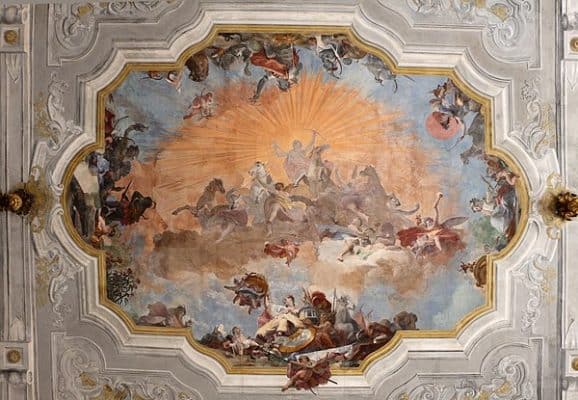
Outside of furniture and architectural design, Rococo frescoes remain memorable. Emblematic of the heavily theatrical aspects of Rococo design, frescoes of the period often used trompe l’oeil (or trick of the eye) features to simulate depth or other locations. Ceiling frescoes with frequently recurring cherubic motifs were made to look like the open sky, for instance.
Art of the Rococo era is also flush with seashells, acanthus leaves, and various flowers. There is a distinct undercurrent of Far Eastern inspiration in some Rococo design, a testament to the growing commercial and cultural interaction between Europe and Asia in the 18th century.
The single most important area of Rococo design remains furniture, however. Rococo furniture is easily identifiable and quite distinct from the periods that surround it.
Features of Rococo Furniture
Rococo furniture is distinguished by its sinuous shapes, bellowing décor, and lavish materials. Because of its whimsical shapes, it inspired lighter, smaller, but more elaborate versions of Baroque stylings.
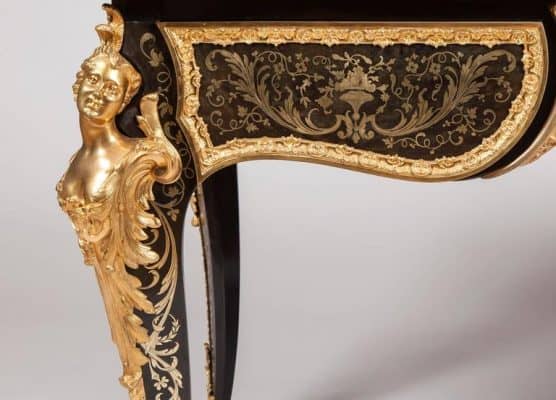
Rococo is often considered full of jocular and joyful elements. In the design of rooms and salons, in particular, Rococo embraced the cherubic whimsy of its primary motifs. Baby angels line the floral gold vines around a Rococo salon, some playing pranks, others playing instruments. The result is a style that is both less serious and more elaborate that Baroque.
On many pieces of Rococo furniture, you will also find ormolu features. Ormolu is a classic Rococo gilding technique that focused on covering brass features with a thin coat of high carat gold. Ormolu techniques feature in many of the gold handles you might find on some of the pieces in our collection.
Rococo Furniture from our Catalogue
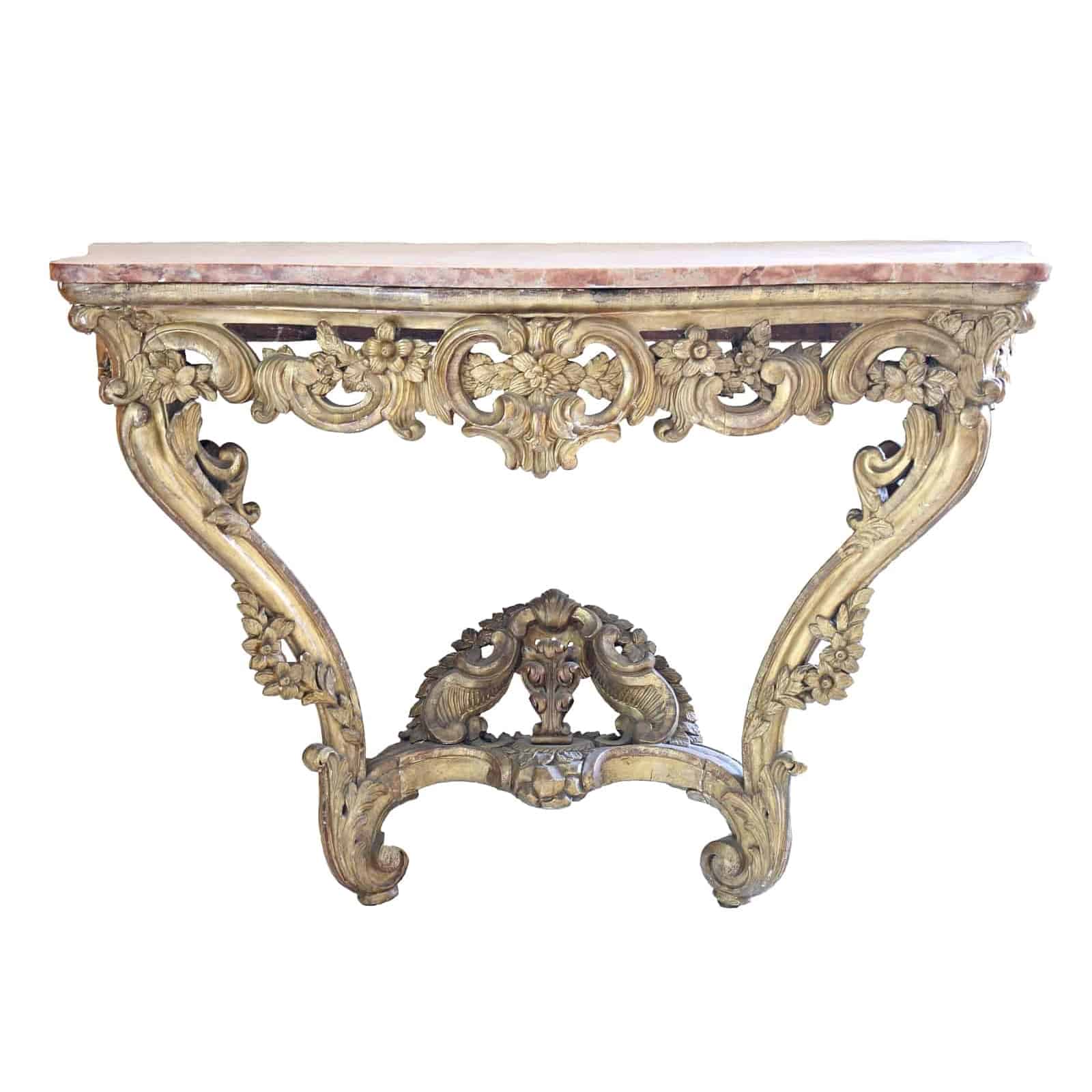
One of the best early examples of Rococo furniture available on Styylish is this picturesque Console Table from the 1750s. Though officially attributed to the Baroque period, it is a transition piece. It embodies the values of rocaille decoration, with gushing floral and seashell motifs swirling around the legs. Note the rose marble top and how it interplays with the golden decor. That bright combination of light colors became a hallmark feature of Rococo.
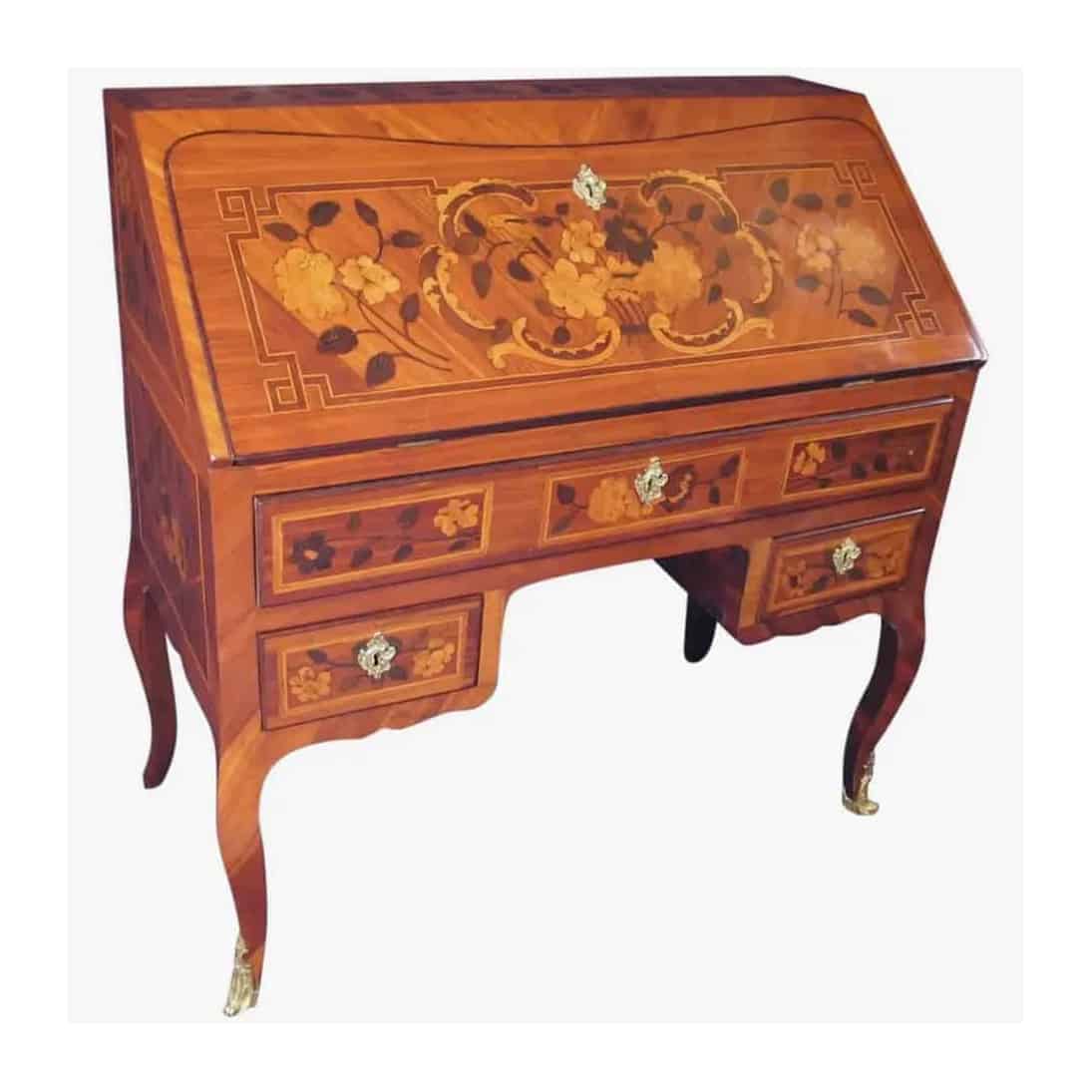
Take a look at this Louis XV Secretary Desk for a later, more understated object. With its gorgeous floral marquetry, it best integrates into a room with lots of natural light, with either neutral, modern furniture, or wood pieces of similar color.
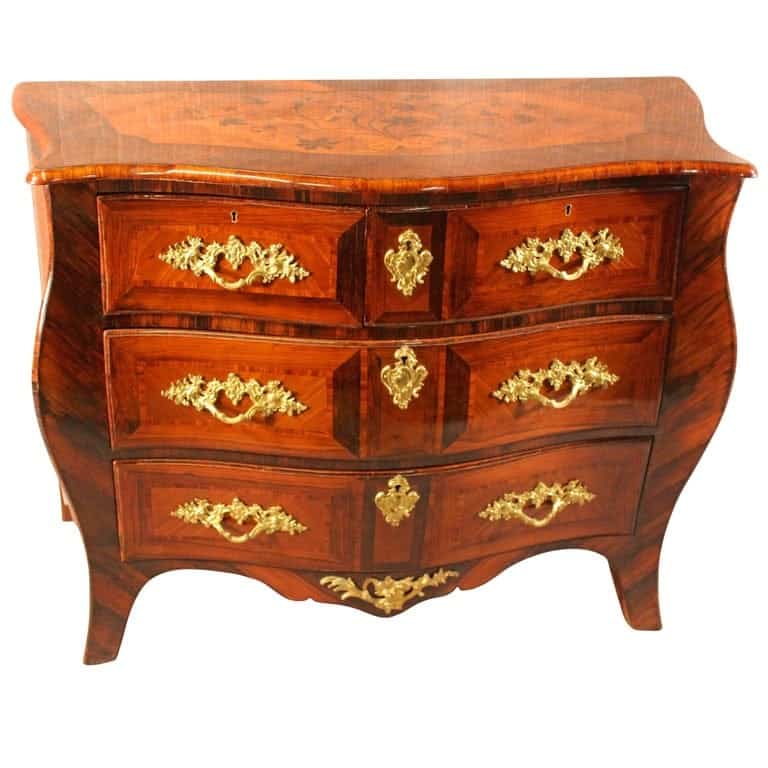
This Louis XV Chest of Drawers which recently sold on Styylish, now graces the living room of a modern apartment. Its exquisite wood veneer top, gold-accented handles, and dark, glossy finish recall the late Rococo period. Fortunately, many pieces of similar caliber remain available on Styylish now. For more information on wood veneer techniques, check out our veneer blog post.
More Dressers in Rococo Style
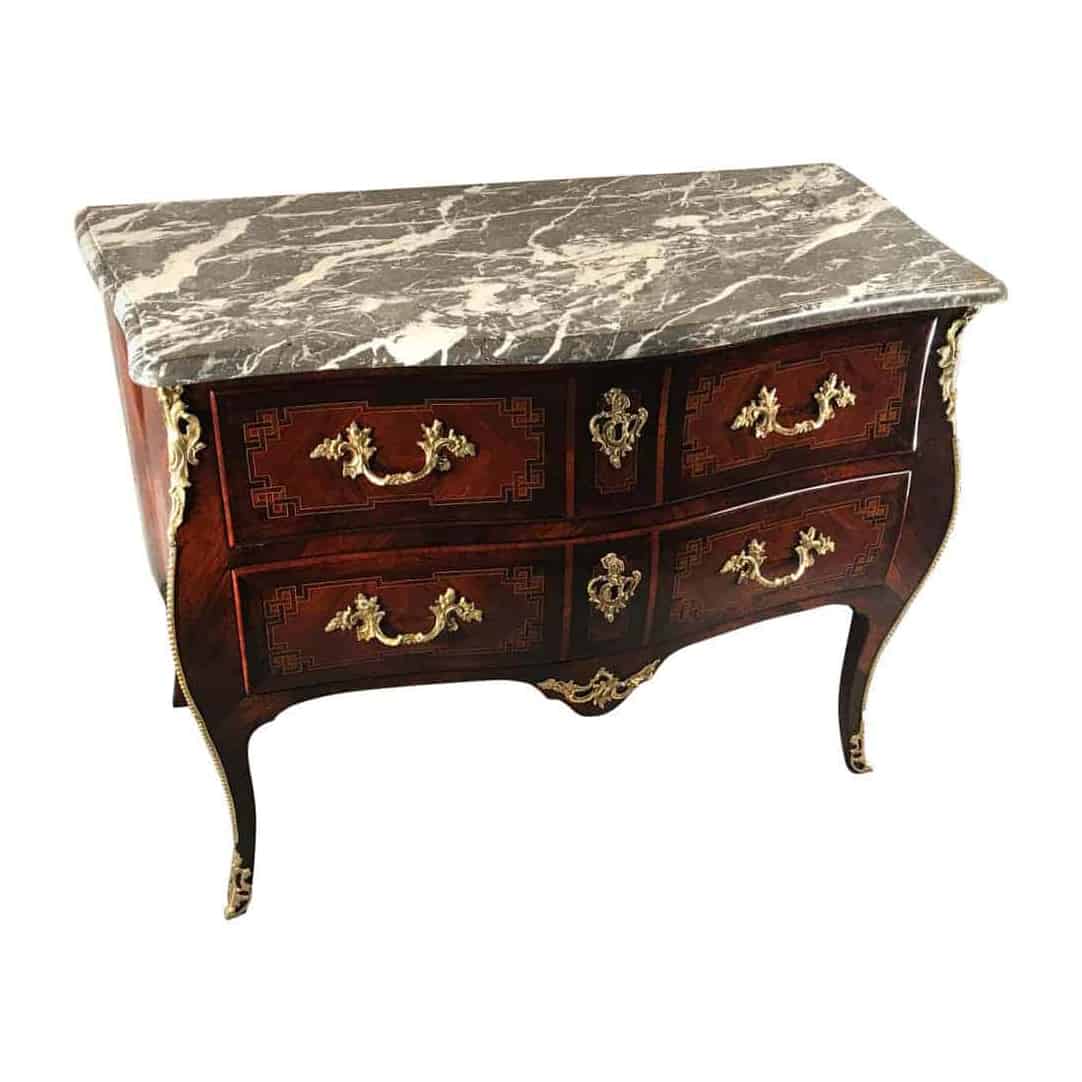
This unbelievably gorgeous Louis XV Antique Dresser with a marble top is rife with luxuriant splendor. The wood veneer encases the ormolu mount handle with geometric elegance, foreshadowing later classical motifs.
That geometry, as well as the darker wood, foreshadow the Louis XVI period, marked by Neoclassicism. This piece remains distinctly Rococo because of its lavishly decorated feet, the natural marble, and the ornate finish on the feet.
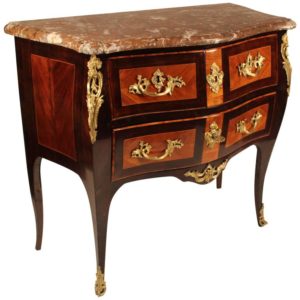
Our Louis XV Commode in Kingwood exemplifies the decorative splendor of Rococo. Kingwood, one of the most reliable furniture woods of the 18th century, forms the structural and decorative basis for this handsome piece. But it is the rose marble top that recalls the court of Louis XV, with its romantic extravagance, and soft warmth.
Beauty in Every Nook
The story of Rococo furniture is the story of lavish beauty. Pieces of exceptional craftsmanship showcase the very best of what a century of artisans had to offer. Made to order for the wealthiest clients in the world, pieces of Rococo furniture carry with them an elite sense of timelessness, as though their very existence is a testament to the potential of art.
Make your way through the Styylish catalogue for even more delightful snapshots of the Rococo age. Bring a slice of old world royalty into your home today!






